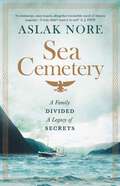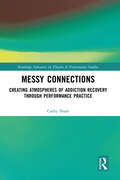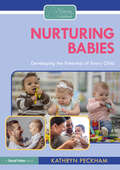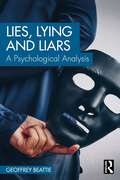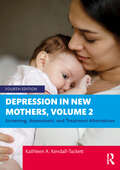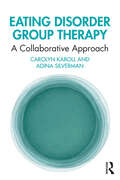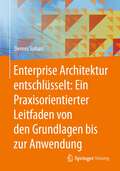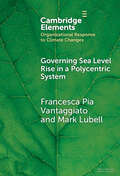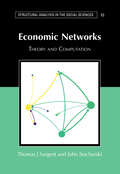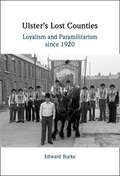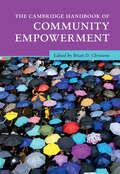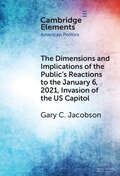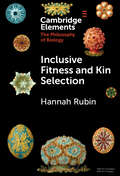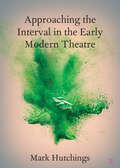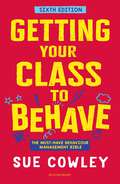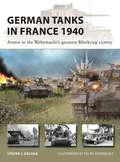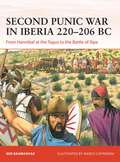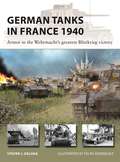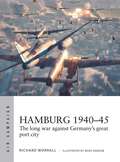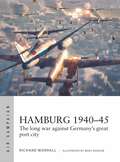- Table View
- List View
The Sea Cemetery: Secrets and lies in a bestselling Norwegian family drama (The Falck Saga #1)
by Aslak Nore"A windswept, wave-tossed, altogether irresistible novel of literary suspense - I truly didn't want it to end" A. J. FINN"In its scale, scope and ambition, The Sea Cemetery is truly epic" COLIN WALSH"This saga will delight fans of 'Succession'" Elle"The strength of its storytelling and its romantic energy make it a perfect example of an authentic page turner" Livres HebdoThere is no love lost between the Oslo and Bergen branches of the powerful Falck family. So when its steely matriarch dies with no will to be found, the seeds of an inheritance dispute are sown.Yet her legacy could be more damaging still. A manuscript confiscated by the secret police in the seventies holds devastating secrets about the Falcks' activities during the war. Her granddaughter Sasha is set on uncovering the truth, whatever the cost, bringing her into conflict with her father, whose family loyalty is matched only by his patriotic fervour. And in the wings waits Hans Falck, war doctor and philanderer, head of the impoverished Bergen branch, who has a few secrets of his own.It all leads back to the sinking of the SS Prinsesse Ragnhild, lost to a British mine in 1940. But can the official verdict be trusted? The shocking truth lies 300 metres under the sea.Part literary thriller, part sweeping family saga, The Sea Cemetery is a dark and dramatic tale of secrets, betrayals and doomed love, drawing on the true story of one of Norway's most devastating maritime disasters.Translated from the Norwegian by Deborah Dawkin
Messy Connections: Creating Atmospheres of Addiction Recovery Through Performance Practice (ISSN)
by Cathy SloanThis book examines performance practices that involve people in recovery from addiction, theorising such practices as recovery-engaged.Focusing on examples of practice from a growing movement of UK-based recovery arts practitioners and performers, it highlights a unique approach to performance that infuses an understanding of lived experiences of addiction and recovery with creative practice. It offers a philosophy of being in recovery that understands lived experience, and performance practice, as a dynamic system of interrelations with the human and nonhuman elements that make up the societal settings in which recovery communities struggle to exist. It thereby frames the process of recovery, and recovery-engaged performance, as an affective ecology – a system of messy connections. Building upon ideas from posthumanist research on addiction, cultural theory on identity and new materialist interpretations of performance practice, it considers how such contemporary theory might offer additional ways of thinking and doing arts practice with people affected by addiction. The discussion highlights the distinct aesthetics, ethics and politics of this area of performance practice.This study will be of great interest to students and scholars in Applied Theatre and Critical Arts and Mental Health studies.
Messy Connections: Creating Atmospheres of Addiction Recovery Through Performance Practice (ISSN)
by Cathy SloanThis book examines performance practices that involve people in recovery from addiction, theorising such practices as recovery-engaged.Focusing on examples of practice from a growing movement of UK-based recovery arts practitioners and performers, it highlights a unique approach to performance that infuses an understanding of lived experiences of addiction and recovery with creative practice. It offers a philosophy of being in recovery that understands lived experience, and performance practice, as a dynamic system of interrelations with the human and nonhuman elements that make up the societal settings in which recovery communities struggle to exist. It thereby frames the process of recovery, and recovery-engaged performance, as an affective ecology – a system of messy connections. Building upon ideas from posthumanist research on addiction, cultural theory on identity and new materialist interpretations of performance practice, it considers how such contemporary theory might offer additional ways of thinking and doing arts practice with people affected by addiction. The discussion highlights the distinct aesthetics, ethics and politics of this area of performance practice.This study will be of great interest to students and scholars in Applied Theatre and Critical Arts and Mental Health studies.
Nurturing Babies: Developing the Potential of Every Child
by Kathryn PeckhamNurturing Babies explores the key processes behind how a child’s mind and body develop in their first year, underpinned by the latest research in the fields of child development, psychology, health and well-being. It shows how the choices practitioners and parents make every day can have a deep impact on children’s experiences and the practices that can be embedded straight away to support their ongoing development and give them the best opportunities for future success.The book follows a holistic approach through the Nurturing Childhoods Pedagogical Framework, learning to understand children's evolving capabilities through their engagement in core behaviours and using these to unlock their full potential. Chapters cover: The importance of sleep and daily routines Playing and communicating with babies Physical activity and healthy eating Early brain development Understanding babies’ emotions and behaviours The importance of emotional security on a child’s well-being Supporting infants to explore and do new things Part of the Nurturing Childhoods series, this exciting book provides practitioners and parents with the knowledge and understanding they need to nurture the very youngest children, building their self-esteem, happiness and well-being as they become enthusiastic lifelong learners.
Nurturing Babies: Developing the Potential of Every Child
by Kathryn PeckhamNurturing Babies explores the key processes behind how a child’s mind and body develop in their first year, underpinned by the latest research in the fields of child development, psychology, health and well-being. It shows how the choices practitioners and parents make every day can have a deep impact on children’s experiences and the practices that can be embedded straight away to support their ongoing development and give them the best opportunities for future success.The book follows a holistic approach through the Nurturing Childhoods Pedagogical Framework, learning to understand children's evolving capabilities through their engagement in core behaviours and using these to unlock their full potential. Chapters cover: The importance of sleep and daily routines Playing and communicating with babies Physical activity and healthy eating Early brain development Understanding babies’ emotions and behaviours The importance of emotional security on a child’s well-being Supporting infants to explore and do new things Part of the Nurturing Childhoods series, this exciting book provides practitioners and parents with the knowledge and understanding they need to nurture the very youngest children, building their self-esteem, happiness and well-being as they become enthusiastic lifelong learners.
Lies, Lying and Liars: A Psychological Analysis
by Geoffrey BeattieLies, Lying and Liars: A Psychological Analysis delves into the psychology of lies, exploring the processes of lying and its far-reaching consequences.The author’s unique approach considers the ways in which lying sculpts our realities when used by public figures such as politicians, as well as how lying is woven into our everyday life. This book dissects lies in natural social contexts, from the innocent childhood fibs to the more nefarious fabrications of con artists, cheats, and adulterers. Drawing from a rich tapestry of psychology and sociobiology, as well as research and literature from philosophy and the social sciences, this book discusses the role of lying and liars in day-to-day life. It offers profound insights into the strategies of deceit, the presence or absence of remorse, emotion and rationalisations, pathological liars, the development of lying, its connection to narcissism, the functional utility of lies, and lie detection. Lies, the book argues, are a part of the social structures inherent in everyday social life, and there is a need to explore their psychological significance in a range of natural, everyday contexts.Written in Beattie’s unique and engaging style by using elements of personal narrative and self-reflection, this is a fascinating read for students and scholars of psychology, sociology, and politics, and other disciplines of the behavioural and social sciences, as well as anyone interested in the phenomenon of lying.
Lies, Lying and Liars: A Psychological Analysis
by Geoffrey BeattieLies, Lying and Liars: A Psychological Analysis delves into the psychology of lies, exploring the processes of lying and its far-reaching consequences.The author’s unique approach considers the ways in which lying sculpts our realities when used by public figures such as politicians, as well as how lying is woven into our everyday life. This book dissects lies in natural social contexts, from the innocent childhood fibs to the more nefarious fabrications of con artists, cheats, and adulterers. Drawing from a rich tapestry of psychology and sociobiology, as well as research and literature from philosophy and the social sciences, this book discusses the role of lying and liars in day-to-day life. It offers profound insights into the strategies of deceit, the presence or absence of remorse, emotion and rationalisations, pathological liars, the development of lying, its connection to narcissism, the functional utility of lies, and lie detection. Lies, the book argues, are a part of the social structures inherent in everyday social life, and there is a need to explore their psychological significance in a range of natural, everyday contexts.Written in Beattie’s unique and engaging style by using elements of personal narrative and self-reflection, this is a fascinating read for students and scholars of psychology, sociology, and politics, and other disciplines of the behavioural and social sciences, as well as anyone interested in the phenomenon of lying.
Depression in New Mothers, Volume 2: Screening, Assessment, and Treatment Alternatives
by Kathleen A. Kendall-TackettThis fourth edition of Depression in New Mothers, Volume 2: Screening, Assessment, and Treatment Alternatives provides a comprehensive and evidence-based approach to understanding the assessment for treatment and treatment of postpartum depression.Depression, anxiety, and posttraumatic stress disorder are common complications of childbirth that result in adverse health outcomes for both mother and child. It is vital, therefore, that health professionals be ready to help women with these conditions in the perinatal period. Written by a psychologist and board-certified lactation consultant, this fourth edition is greatly expanded and available as two complementary volumes. Focusing on causes and consequences of poor perinatal mental health and its treatment. It can also be used by community organizations that want to support new mothers, screen for possible depression, discuss treatment options, and refer them to appropriate care. This volume integrates current international research and includes chapters on:● Choosing an assessment scale to measure depression and co-occurring conditions● Developing a treatment plan● Supporting new mothers and families through community interventions● Using complementary and integrative therapies● Providing evidence-based psychotherapy● Using antidepressantsDepression in New Mothers, Volume 2 (4th Edition) includes case illustrations throughout and retains its focus on moving research into practice. It is an essential resource for all healthcare practitioners working with mothers in the perinatal period, including mental health providers, nurses, midwives, doctors, lactation consultants, and peer supporters.
Depression in New Mothers, Volume 2: Screening, Assessment, and Treatment Alternatives
by Kathleen A. Kendall-TackettThis fourth edition of Depression in New Mothers, Volume 2: Screening, Assessment, and Treatment Alternatives provides a comprehensive and evidence-based approach to understanding the assessment for treatment and treatment of postpartum depression.Depression, anxiety, and posttraumatic stress disorder are common complications of childbirth that result in adverse health outcomes for both mother and child. It is vital, therefore, that health professionals be ready to help women with these conditions in the perinatal period. Written by a psychologist and board-certified lactation consultant, this fourth edition is greatly expanded and available as two complementary volumes. Focusing on causes and consequences of poor perinatal mental health and its treatment. It can also be used by community organizations that want to support new mothers, screen for possible depression, discuss treatment options, and refer them to appropriate care. This volume integrates current international research and includes chapters on:● Choosing an assessment scale to measure depression and co-occurring conditions● Developing a treatment plan● Supporting new mothers and families through community interventions● Using complementary and integrative therapies● Providing evidence-based psychotherapy● Using antidepressantsDepression in New Mothers, Volume 2 (4th Edition) includes case illustrations throughout and retains its focus on moving research into practice. It is an essential resource for all healthcare practitioners working with mothers in the perinatal period, including mental health providers, nurses, midwives, doctors, lactation consultants, and peer supporters.
Eating Disorder Group Therapy: A Collaborative Approach
by Carolyn Karoll Adina SilvermanThis is the only book that teaches clinicians how to run an effective, evidence-informed, and multi-disciplinary eating disorder group, incorporating psychoeducation, process group dynamics, and experiential elements.Whereas group therapy for eating disorders is widely used across many levels of care, the outpatient setting is uniquely poised to deliver effective, multi-disciplinary group therapy. The first part of this book offers practical guidance for conceiving, organizing, and initiating outpatient groups, equipping clinicians with the necessary tools to foster supportive and transformative environments. The second includes seven chapters that delve into the core themes of eating disorder recovery, featuring 60 activities and discussions empowering participants towards growth and resilience. This book teaches clinicians how to collaboratively lead groups to optimize cohesion and harness the collective strength of the group to facilitate change. It provides thorough rationale and psychoeducation for each group exercise and is complete with sample forms, worksheets, and handouts.Suitable for clinicians and students alike in the eating disorder field, this guide on how to successfully begin and run your own group is a necessary resource.
Eating Disorder Group Therapy: A Collaborative Approach
by Carolyn Karoll Adina SilvermanThis is the only book that teaches clinicians how to run an effective, evidence-informed, and multi-disciplinary eating disorder group, incorporating psychoeducation, process group dynamics, and experiential elements.Whereas group therapy for eating disorders is widely used across many levels of care, the outpatient setting is uniquely poised to deliver effective, multi-disciplinary group therapy. The first part of this book offers practical guidance for conceiving, organizing, and initiating outpatient groups, equipping clinicians with the necessary tools to foster supportive and transformative environments. The second includes seven chapters that delve into the core themes of eating disorder recovery, featuring 60 activities and discussions empowering participants towards growth and resilience. This book teaches clinicians how to collaboratively lead groups to optimize cohesion and harness the collective strength of the group to facilitate change. It provides thorough rationale and psychoeducation for each group exercise and is complete with sample forms, worksheets, and handouts.Suitable for clinicians and students alike in the eating disorder field, this guide on how to successfully begin and run your own group is a necessary resource.
Enterprise Architektur entschlüsselt: Ein Praxisorientierter Leitfaden von den Grundlagen bis zur Anwendung
by Dennis SuhariEntdecken Sie "Enterprise Architektur entschlüsselt: Ein praxisorientierter Leitfaden von den Grundlagen bis zur Anwendung“ von Dennis Suhari, ein praxisorientiertes Werk, das die Förderung des Bewusstseins für Enterprise Architektur, die Vermittlung praktischer Erfahrungen und die Unterstützung der Leser bei der erfolgreichen Anwendung ihres Wissens in den Mittelpunkt stellt. Ein Schlüsselelement dieses Buches ist das praxisnahe Fallbeispiel, das einen einzigartigen Einblick in den Aufbau einer Enterprise Architektur von der Geschäfts- über die IT Architektur von Grund auf bietet.Was Sie erwartet:Fundamentale Grundlagen: Ein tiefgreifender Einblick in die essenziellen Grundlagen der Unternehmensarchitektur, um Schlüsselkonzepte und Prinzipien zu vermitteln, die als robuste Basis für die weitere Entwicklung dienen.Modellierung und praktische Tools: Entdecken Sie vielfältige Modellierungsmöglichkeiten und EAM-Tools, die inder Praxis zur Unterstützung der Architekturentwicklung eingesetzt werden.Architekturentwicklung in der Praxis: Anhand des Fallbeispiels der fiktiven Micayu GmbH, basierend auf den umfangreichen Erfahrungen des Autors, erleben Sie die Schritte der Entwicklung einer Unternehmensarchitektur von Grund auf.Zukunftsperspektiven: Ein Ausblick auf die Rolle der Künstlichen Intelligenz und dessen Einfluss auf das Enterprise Architektur Management
Governing Sea Level Rise in a Polycentric System: Easier Said than Done (Organizational Response to Climate Change: Businesses, Governments)
by null Francesca Pia Vantaggiato null Mark LubellHow do polycentric governance systems respond to new collective action problems? This Element tackles this question by studying the governance of adaptation to sea level rise in the San Francisco Bay Area of California. Like climate mitigation, climate adaptation has public good characteristics and therefore poses collective action problems of coordination and cooperation. The Element brings together the literature on adaptation planning with the Ecology of Games framework, a theory of polycentricity combining rational choice institutionalism with social network theory, to investigate how policy actors address the collective action problems of climate adaptation: the key barriers to coordination they perceive, the collaborative relationships they form, and their assessment of the quality of the cooperation process in the policy forums they attend. Using both qualitative and quantitative data and analysis, the Element finds that polycentric governance systems can address coordination problems by fostering the emergence of leaders who reduce transaction and information costs. Polycentric systems, however, struggle to address issues of inequality and redistribution.
Economic Networks: Theory and Computation (Structural Analysis in the Social Sciences)
by null Thomas J. Sargent null John StachurskiIt has become increasingly clear that economies can fruitfully be viewed as networks, consisting of millions of nodes (households, firms, banks, etc.) connected by business, social, and legal relationships. These relationships shape many outcomes that economists often measure. Over the past few years, research on production networks has flourished, as economists try to understand supply-side dynamics, default cascades, aggregate fluctuations, and many other phenomena. Economic Networks provides a brisk introduction to network analysis that is self-contained, rigorous, and illustrated with many figures, diagrams and listings with computer code. Network methods are put to work analyzing production networks, financial networks, and other related topics (including optimal transport, another highly active research field). Visualizations using recent data bring key ideas to life.
Ulster's Lost Counties: Loyalism and Paramilitarism since 1920
by null Edward BurkeIn 1920, the three Ulster counties of Cavan, Donegal and Monaghan were excluded from Northern Ireland. What happens to an abandoned people? And what is the impact on subsequent generations? At a time of uncertainty over the future of Northern Ireland, the history of Ulster loyalists who found themselves on the 'wrong side' of the Irish border is especially relevant. Memories of the violence and betrayal experienced by one generation of protestants in the three counties entrenched an intergenerational Ulster loyalist identity. Subsequently, three-county loyalists who moved across the border played an important role in militant politics. Examining armed resistance in these counties and the radicals who came from them, Edward Burke argues that violence or terrorism perpetrated by 'lost Ulster' loyalists enjoyed considerable success. Spanning the Anglo-Irish War to the Troubles and beyond, Ulster's Lost Counties demonstrates the grip of identity and betrayal since the partition of Ireland.
The Cambridge Handbook of Community Empowerment (Cambridge Handbooks in Psychology)
by Brian D. ChristensPower and empowerment are critical topics for social change. This handbook maps out ways that people can collectively engage with, influence, and change systems that affect their lives, particularly the systems that maintain inequality and oppression. It includes in-depth examinations of a variety of approaches to building and exercising community power in local organizations, institutions, and settings. Each chapter examines a particular approach, critically engaging with contemporary research on how and when collective action can be most effective at producing change within communities and societal systems. By examining a range of approaches in diverse contexts, this book provides new insights for scholars, practitioners, and engaged resident-leaders aiming to be more precise, strategic, and innovative in their efforts to build and sustain community power. It is the ideal resource for those working with community groups to build more just and equitable systems.
The Dimensions and Implications of the Public's Reactions to the January 6, 2021, Invasion of the U.S. Capitol (Elements in American Politics)
by null Gary C. JacobsonThe January 6, 2021 invasion of the US Capitol building by a mob trying to block certification of Biden's victory attacked a bedrock principle of American democracy, the peaceful transfer of power following an election. This Element reviews how the pubic evaluated the invaders, their actions, Donald Trump's responsibility, and the House investigations as they evolved after January 6. It then analyzes these reactions in the broader context of contemporary American politics and considers the consequences of January 6 for the 2022 election, the Republican coalition, polarization, Trump's indictments, electoral politics in 2024, and the future health of American democracy.
Inclusive Fitness and Kin Selection (Elements in the Philosophy of Biology)
by null Hannah RubinThe biological world is full of phenomena that seem to run counter to Darwin's insight that natural selection can lead to the appearance of design. For instance, why do organisms in some species divide reproductive labor? The existence of non-reproducing organisms in such 'eusocial' species looks to be at odds with an evolutionary theory which posits traits exist because they help organisms survive and reproduce. What is the evolutionary advantage of an insect being distasteful to its predators? The distastefulness appears designed to deter predators, but can only affect the predator's actions when the insect is eaten; it is hard to see how such a trait could be passed on. This Element will cover the shared foundations of evolutionary explanations for these and other seemingly puzzling phenomena, focusing on the concepts of inclusive fitness and kin selection.
Approaching the Interval in the Early Modern Theatre: The Significance of the 'Act-Time' (Elements in Shakespeare Performance)
by null Mark HutchingsIn requiring artificial light, the early modern indoor theatre had to interrupt the action so that the candles could be attended to, if necessary. The origin of the five-act, four-interval play was not classical drama but candle technology. This Element explores the implications of this aspect of playmaking. Drawing on evidence in surviving texts it explores how the interval affected composition and stagecraft, how it provided opportunities for stage-sitters, and how amphitheatre plays were converted for indoor performance (and vice versa). Recovering the interval yields new insights into familiar texts and brings into the foreground interesting examples of how the interval functioned in lesser-known plays. This Element concludes with a discussion of how this aspect of theatre might feed into the debate over the King's Men's repertory management in its Globe-Blackfriars years and sets out the wider implications for both the modern theatre and the academy.
Getting Your Class to Behave: The must-have behaviour management bible
by Ms Sue CowleySue Cowley's bestselling behaviour guide is back, updated and better than ever. 'Day after day, you arrive at your job, only to face students who simply will not behave. You begin to dread coming into work, knowing that you have to face such a difficult day… What can you do? First, read this book.'In this brand new edition, Sue takes a detailed look at positive behaviour management, considers recent advances in understanding self-regulation, and offers specific advice on tackling behavioural challenges in the post-Covid classroom. Getting Your Class to Behave is the positive, practical answer to poor behaviour you've been looking for!The latest and greatest edition of the classic Getting the Buggers to Behave, this behaviour management bible has long been a firm favourite with trainees, early career teachers and experienced staff alike. The advice ranges from the basics of behaviour management to how to deal with any tricky class and is applicable whether you are working in the early years, primary, secondary or further education. Sue offers honest, straightforward support with case studies, anecdotes and level-specific examples in every chapter. Sue knows that no matter how much passion and care you have for the job, there's no match for poor behaviour like tried-and-tested techniques. If your two-year-olds are ignoring you, your Year 11s are distracted, or your tutor group is not-so-quietly chaotic then this is the book for you!
German Tanks in France 1940: Armor in the Wehrmacht's greatest Blitzkrieg victory (New Vanguard #327)
by Steven J. ZalogaA fully illustrated new assessment of the German tank force that won its greatest victory in France during 1940.The German conquest of France in 1940 was arguably the Wehrmacht's greatest military achievement, conquering France in several weeks after having failed to do so in World War I. New Panzer tactics, dubbed 'Blitzkrieg', were at the heart of the German victory.In this book, renowned armor expert Steven J. Zaloga reassesses the armored force that made the triumph possible, and explains that although the German Panzers won their reputation in France, they were far from being a technological juggernaut. The vast majority were the small PzKpfw I and PzKpfw II light tanks. The more effective medium tanks such as the PzKpfw III and PzKpfw IV were available in relatively small numbers. Their effectiveness had far more to do with training and doctrine than technology. With illustrations including unpublished photos and superb new artwork, this book examines the wide range of German tanks employed in France in 1940, as well as their organization and tactical doctrine.
Second Punic War in Iberia 220–206 BC: From Hannibal at the Tagus to the Battle of Ilipa (Campaign #400)
by Mir BahmanyarThe first dedicated, illustrated study of the events of the Second Punic War in Iberia, which served as a launch pad for the Carthaginian invasion of Rome.Iberia was one of three crucial theatres of the Second Punic War between Carthage and Rome. Hannibal of Carthage's siege of Saguntum in 219 BC triggered a conflict that led to immense human and material losses on both sides, pitting his brother Hasdrubal against the Republican Roman armies seeking to gain control of the peninsula. Then, in 208 BC, the famous Roman general Scipio Africanus defeated Hasdrubal at Baecula, forcing Hasdrubal's army out of Iberia and on to its eventual annihilation at the Metaurus. In this work, military historian Mir Bahmanyar brings to life the key personalities and events of this important theatre of the war, and explains why the Roman victory at Baecula led to a strategic shift and Carthage's eventual defeat. It covers Scipio Africanus' brilliant victory at Ilipa in 206 BC, where he crushed the army of Mago Barca and Hasdrubal Gisco. Illustrated with maps, tactical diagrams, battlescene artworks and photographs, this work provides a gripping narrative of the large-scale battles fought in Iberia.
German Tanks in France 1940: Armor in the Wehrmacht's greatest Blitzkrieg victory (New Vanguard #327)
by Steven J. ZalogaA fully illustrated new assessment of the German tank force that won its greatest victory in France during 1940.The German conquest of France in 1940 was arguably the Wehrmacht's greatest military achievement, conquering France in several weeks after having failed to do so in World War I. New Panzer tactics, dubbed 'Blitzkrieg', were at the heart of the German victory.In this book, renowned armor expert Steven J. Zaloga reassesses the armored force that made the triumph possible, and explains that although the German Panzers won their reputation in France, they were far from being a technological juggernaut. The vast majority were the small PzKpfw I and PzKpfw II light tanks. The more effective medium tanks such as the PzKpfw III and PzKpfw IV were available in relatively small numbers. Their effectiveness had far more to do with training and doctrine than technology. With illustrations including unpublished photos and superb new artwork, this book examines the wide range of German tanks employed in France in 1940, as well as their organization and tactical doctrine.
Hamburg 1940–45: The long war against Germany's great port city (Air Campaign #44)
by Richard WorrallThe first book to cover the full history of the RAF's air war against Hamburg, one of the most important target cities in Germany. The city of Hamburg became synonymous with the destructive power of RAF Bomber Command when, during summer 1943, the city suffered horrific destruction in a series of four heavy firebombing attacks, Operation Gomorrah. However, few know how varied or long the Hamburg campaign was. In this book, RAF air power expert Dr Richard Worrall presents the complete history of the RAF's air campaign against the city, a campaign that stretched well beyond the devastating fire raids of 1943. Dr Worrall explains how Germany's second city was an industrial centre of immense proportions and proved a consistent target for Bomber Command throughout World War II. It was home to oil refineries, U-boat pens, and ship-building and submarine-building yards, all sustained by a large industrial workforce. Bomber Command evolved tactically and technically throughout the war, and the Luftwaffe's defensive capabilities would do likewise in response. Drawing on a wide range of primary and secondary sources available on this topic, and packed with photos, artwork, maps and diagrams, this is an important new history of the air campaign against the industrial and naval heart of Nazi Germany.
Hamburg 1940–45: The long war against Germany's great port city (Air Campaign #44)
by Richard WorrallThe first book to cover the full history of the RAF's air war against Hamburg, one of the most important target cities in Germany. The city of Hamburg became synonymous with the destructive power of RAF Bomber Command when, during summer 1943, the city suffered horrific destruction in a series of four heavy firebombing attacks, Operation Gomorrah. However, few know how varied or long the Hamburg campaign was. In this book, RAF air power expert Dr Richard Worrall presents the complete history of the RAF's air campaign against the city, a campaign that stretched well beyond the devastating fire raids of 1943. Dr Worrall explains how Germany's second city was an industrial centre of immense proportions and proved a consistent target for Bomber Command throughout World War II. It was home to oil refineries, U-boat pens, and ship-building and submarine-building yards, all sustained by a large industrial workforce. Bomber Command evolved tactically and technically throughout the war, and the Luftwaffe's defensive capabilities would do likewise in response. Drawing on a wide range of primary and secondary sources available on this topic, and packed with photos, artwork, maps and diagrams, this is an important new history of the air campaign against the industrial and naval heart of Nazi Germany.
